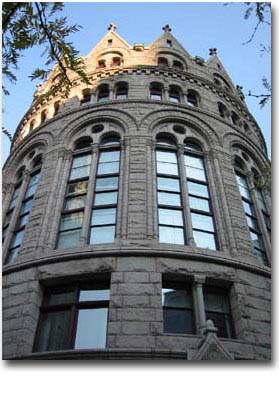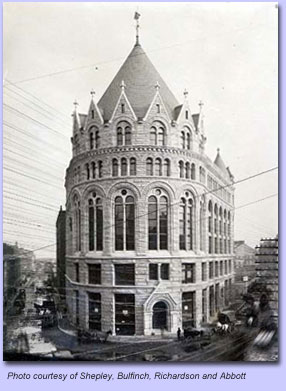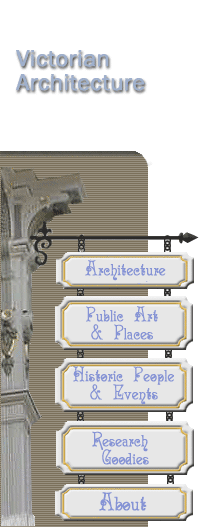|
Flour and Grain Exchange
Building
Inaugurated January
20, 1892
Shepley, Rutan and Coolidge
(now Shepley,
Bulfinch, Richardson and Abbott)
 Another
castle in Boston! The
Flour and Grain Exchange building, which was originally created for the
consolidation of two corporate trade bodies - the Boston Commercial Exchange
and the Boston Produce Exchange that later became the Boston Chamber of
Commerce in 1885. Another
castle in Boston! The
Flour and Grain Exchange building, which was originally created for the
consolidation of two corporate trade bodies - the Boston Commercial Exchange
and the Boston Produce Exchange that later became the Boston Chamber of
Commerce in 1885.
The building was designed
by the architecture firm of Shepley, Rutan and Coolidge, which
is now Shepley, Bulfinch, Richardson and Abbott, and constructed
upon land donated by Henry M. Whitney, an influential developer (who built
the first electric-powered streetcar ride in Allston-Brighton in December
1888).
The rusticated
masonry and multi-tiered arches exemplify the Richardsonian Romanesque
style associated with H.H. Richardson, the architecture firm's original
principal. The impressive walls and bold appearance reflect an expression
of financial security that was appropriate to the city’s commercial circles.
|
BOSTON
CHAMBER OF COMMERCE
DESCRIPTION OF BUILDING *
 The
excavation for the building was begun in the early part of May 1890.
The corner stone was laid Sept. 29, 1890. The building was completed
in January 1892. The
excavation for the building was begun in the early part of May 1890.
The corner stone was laid Sept. 29, 1890. The building was completed
in January 1892.
The
building stands on piles, each pile holding seven and one-half tons.
The foundation is made of granite, the basement walls being lined
with hollow brick. The basement floor of the building is composed
of one foot of Portland cement concrete, on which is laid a course
of tarred paper, on which the wooden floors are placed. The boiler-room
floor, being below high-water mark, has two feet of Portland cement
concrete on the bottom and on the sides, and then covered with brick.
The
exterior walls of the building are made of pink Worcester Quarry
granite from Milford, Mass., and are backed with solid brick and
faced on the inside with hollow brick, the plaster of the rooms
being placed directly on the hollow brick.
The
floors of the vestibules and lower corridors are laid with marble
tile, and the vestibules and lower corridors are wainscoted with
white Italian marble. All corridors above the first story are wainscoted
in oak, with rift sawed yellow pine floors. The
Board Room is wainscoted thirteen feet high in panelled oak, with
maple floor, and the domed ceiling made of iron and plastered.
The
pyramidal roof is made of iron covered with black slate, the slate
being tied to the iron frame with copper wire. The floors and ceilings
of the offices in the sixth and seventh stories over the Board Room
are suspended from this roof. All
the interior finish of the building is quartered oak.
|
|



